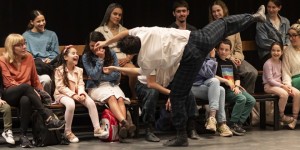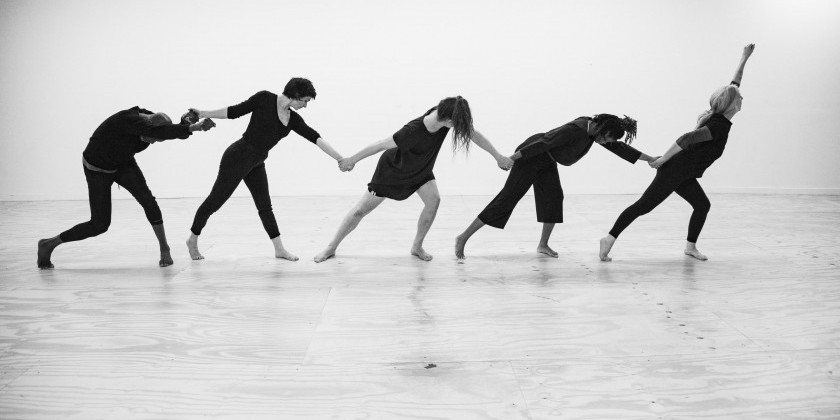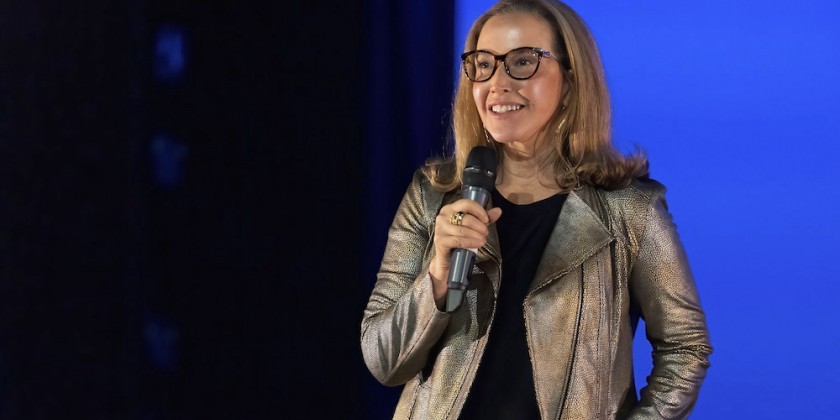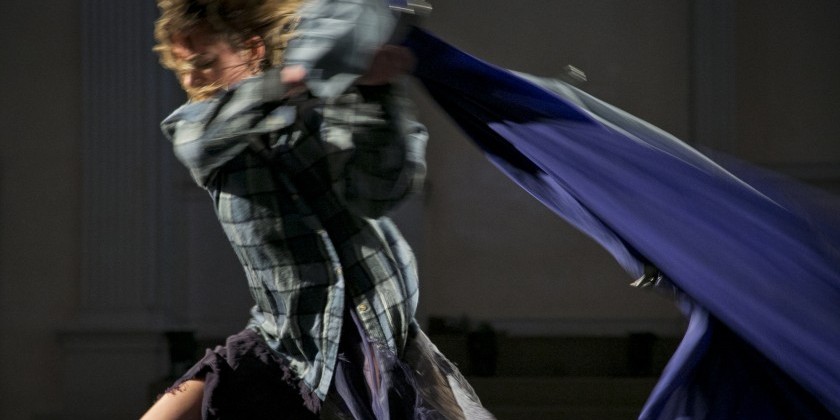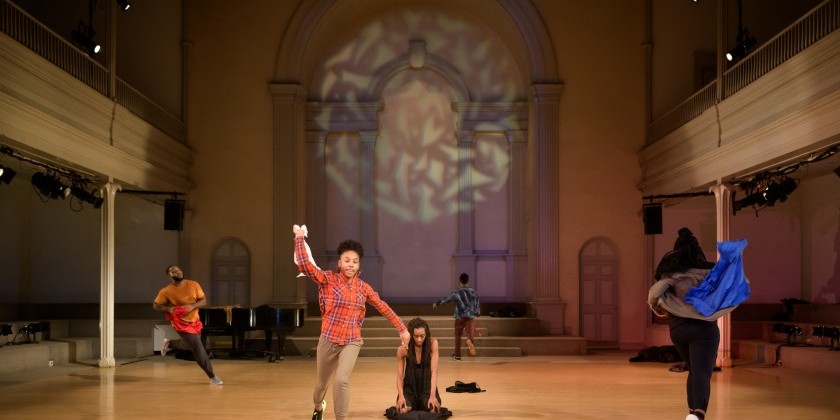Tina Croll, Keely Garfield and Pilobolus on 92Y’s Harkness Dance Festival

Celebrating Innovators and History Makers
92nd Street Y Harkness Dance Festival
92nd Street Y, 1395 Lexington Ave, New York, NY 10128
$25-$35 at http://www.92y.org/harknessfestival or 212.415.5500
Keely Garfield Dance: Pow - Fri, Feb 26, Sat, Feb 27, Sunday Feb 28, 8 p.m.
Pilobolus: Rules @ Play – FOR ADULTS & FAMILIES - Sat, Mar 5, 3 p.m.
Tina Croll + Company: One Rhinoceros, 3 Birds and a Pineapple - Fri, Mar 18 and Sat, Mar 19, 8 p.m.; Sun, Mar 20, 3 p.m.
Since 1935, 92Y’s Harkness Dance Center has been a home for dance. Martha Graham, Hanya Holm, Katherine Dunham, Agnes de Mille, Jerome Robbins and Merce Cunningham, among many others, have taught and performed there throughout its storied history.
It only seems fitting that this year’s Harkness Dance Festival celebrates innovators and history makers of contemporary dance. It also marks the re-opening of the Kaufmann Concert Hall with Pilobolus being the first dance company in many years to perform in the theater.
The Dance Enthusiast caught up with the choreographers and companies who are performing in this year’s festival. Here are excerpts from our conversations.

Trina Mannino for The Dance Enthusiast: Can you tell us about your early forays into dance making? And, how has your work since evolved?
Tina Croll: One of my early works was called At the Back of the Closet. It started as a solo where I ripped off all my clothes then went on to a duet that included spoken text about how apes behave when they’re learning to speak. I think one of the ways my work has changed is that I am now very interested in choreographing dances that have large groups — sometimes with as many as 20 dancers. There is something very powerful about groups dancing in unison.
Keely Garfield: Since I made my first actual dance when I was twelve you would think my work must have evolved a bit, but on some level, I am probably still looking into the same patch of sky that captivated my mind and body in the first place. All of the moving parts, the way things shift, the spaces in-between coming and going, making something from nothing, feeling brave, feeling yourself falling, getting up again, dancing together and apart, and in the end not much to show for it, except for everything.
I think for many artists, there is a natural evolution from initially expressing ideas about the self and individualism, to finding our place in the family of things and our relationship to community, followed by the emergence of a global, even universal point of view. For the dance artist, an immersion in the body and its teachings leads to a curiosity and engagement with the larger body of the world. So, the little solo I made when I was a kid at school about this and that, grew up to become the solo I am doing now about this and that. The particulars of what exactly this and that are, have changed in scope, design, capacity, nuance, and significance but not in essential ways. Place and time differ, skills accrue, new things come to light but origins are undeniable.
Itamar Kubovy, Piobolus’s Executive Producer: The spirit of the early 70s was strongly present in the origins of the company. The thought that once could rely on intelligence, group commitment, curiosity, and a healthy amount of ignorance in the creation of amazing things was always at the core of the ethos and still applies today.
When the original members of the company made the first dance, Pilobolus, it was fresh and new and cheeky. It was a young work, but I have heard Robby Barnett [one of the company’s artistic directors] say 40 years later that he believes that the dance contained the seeds for everything the company has done since. I do not disagree.

Tina Croll + Company; Photo courtesy of company/92Y Harkness Dance Festival
TDE: Can you share one dance that you will be perform during the festival?
TC: One of the dances is Balkan Dreams. I presented it at Danspace Project with 20 musicians, some of which who were part of the Balkan Brass Band.
I started doing Balkan folk dances many years ago, and when I heard the music, I was immediately drawn to it. For many years, I thought I’d like to do a dance about it, but it always seemed too complicated. When I first heard the music, I could hardly count it. One part has 22 beats per measure. I find that the variety of rhythms very interesting to work with. I realize that [the emphasis of rhythm] it even shows up in other work that is to completely different music.
KG: At first glance, Pow is a “Frankenstein” of a dance summoned from bits of dances I have made before as well as many fresh and raw things, sutured together and left to run amok in a brave new-fangled version. In truth, Pow was precipitated by a monstrous turn of events that detonated my life once again, and it has much to say about fortitude and the power there is in remaining embodied, feeling and experiencing everything fully, despite difficult and painful situations. Scraps of fear and loathing are boldly transformed, and resilience is made palpable. Through rigorous and scrupulous dancing, we piece together a novel account on the nature of corporeal and spiritual valor in which the dancing body shines through.
IK: Rules @ Play is our attempt to tell young people and their families about one of the most important requirements for creativity -- rules! By looking at rules from multiple angles, and giving live, performed examples in our classic repertory, we let the audience get into the director's shoes and participate in the making of the show. It’s really a great program for any adult interested in the creative process, as well as for their kids.
The audience in Rules @ Play will get to choreograph a dance from their seats, and some of its young people will have the chance to make an improvisational dance on the main stage and perform it during the show.
In a traditional concert there is still a gulf between the audience watching quietly in the dark and the dancers performing lit beautifully on stage. With a show like Rules @ Play, we create a very different atmosphere in the theater in which we try to minimize the difference between performer and audience member and mix up all the rules.
TDE: The concentration of this Harkness Dance Festival 2016 is on dance innovators and history makers. What does the term history maker mean to you? Which history maker has influenced your way of doing things?
TC: That’s a challenging question. They’re someone who has persevered and has a strong body of work for a long period of time. They can also be an individual who suddenly breaks boundaries…
Merce’s [Cunningham] incredibly dramatic performing presence was captivating. His company of eight could be running, turning or leaping, and he would be upstage doing some very tiny move, maybe scratching his calf. You would be riveted by what he was doing and not even see them. So much was going on inside of him at every moment.
IK: History makers are - by definition - influencers that changed the way the story of our art form is told. Different stories have different history makers and some history makers belong to many makers' stories.
For Pilobolus, the influencers are diverse and often come from outside the world of dance, from fields like music, magic, comics, biology, and robotics, as well as from outsider artists who have a unique way of seeing things. In the dance world, if I had to pick one group, Alwin Nikolais and Murray Louis played a significant role and had an influence on early Pilobolus.
KG: The angel of history is said to cast her back on the future as she turns her face towards the past. If we can only know where we are because of where we came from then I am from one simple, long ago and far away, act. Jayne Layton was my dance teacher when I was young and hopeless. She was the only person in the world who believed in me. She saw my future even if I could not - just like in the movies, complete with a happy ending, although the future necessarily remains dark.
Share Your Audience Review. Your Words Are Valuable to Dance.
Are you going to see this show, or have you seen it? Share "your" review here on The Dance Enthusiast. Your words are valuable. They help artists, educate audiences, and support the dance field in general. There is no need to be a professional critic. Just click through to our Audience Review Section and you will have the option to write free-form, or answer our helpful Enthusiast Review Questionnaire, or if you feel creative, even write a haiku review. So join the conversation.





